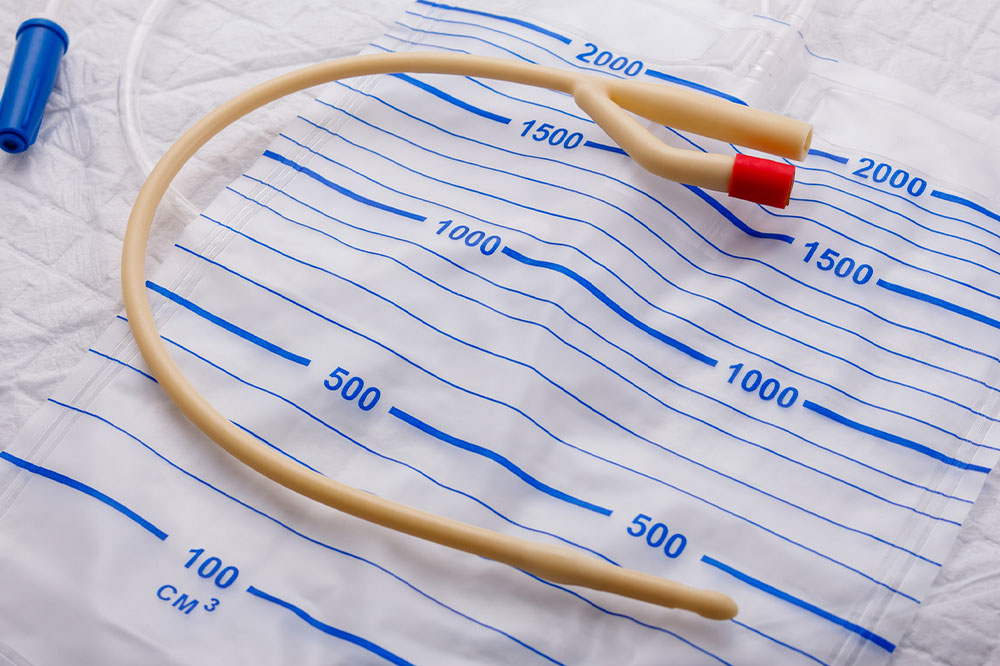
Urinary catheters – Types and their side effects
A urinary catheter is a thin tube used to drain and collect urine from the bladder. It is recommended for patients who have problems like urine leakage, urinary retention or inability to empty the bladder, prostate or genital surgery, or conditions like multiple sclerosis, dementia, and spinal cord injury. Catheters are available in various sizes, materials, and types. This article provides insight into the main types of urine catheters and their possible side effects.
Intermittent catheter (short-term catheter)
This type of catheter comes with a thin, flexible tube that is inserted into the bladder through the urethra. The external tip of the tube is left open, allowing urine to drain into a hole, or it is attached to a drainage bag that collects the urine. After every urination, patients need to remove the catheter and insert a new one. It needs to be done multiple times a day. It can be done through the urethra or through a hole created in the lower abdomen. Your healthcare provider will train you to do this accurately. Intermittent catheters are typically used after surgery to empty the bladder.
Side effects: One of the most common side effects is urinary tract infection (UTI). Hematuria is another possible effect. It causes the urine to appear red or brown because of the presence of red blood cells. First-time users are likely to get hematuria, but if it keeps appearing, it is a symptom of a UTI. A bladder stone is also common for those who use an intermittent catheter. Urethral strictures may occur, which is the narrowing of the urethra from repeated trauma. Those who insert intermittent catheters for long months are at higher risk.
Indwelling catheter
An indwelling catheter is used for a more extended period, unlike an intermittent catheter. A small balloon is inflated with sterile water at the end of the catheter so that the tube does not slide from the body. The balloon is deflated when the catheter needs to be removed. Indwelling catheters are inserted through the urethra. This type is called a urethral or a Foley catheter. When it is inserted into the bladder through a tiny hole in the abdomen, it is called a suprapubic catheter. This procedure is carried out by a doctor. Indwelling catheters mostly collect urine in a drainage bag that is strapped to the patient’s inner thigh or positioned lower than the abdomen. Patients should always empty the drainage bag once it becomes full and attach it with a clean, unused one. Certain types of indwelling catheters have a valve instead of a bag. Patients have to open the valve to empty and drain the urine. Some people find this more convenient than a drainage bag.
Side effects: Bladder spasm is a common side effect that occurs when the bladder tries to pass urine out from the balloon section. Your healthcare provider may prescribe antibiotics to lessen the frequency. Patients using indwelling catheters may notice debris in the tube. This is normal but sometimes can block the tube and prevent drainage. Individuals should inform their doctors immediately if the catheter becomes blocked or if they notice blood clots or large pieces of debris. Indwelling catheters are not comfortable and often cause pain. Consult your doctor for a solution if the pain is too much.
External catheters (condom catheters)
Such types of catheters are placed outside the body. They are typically used by people with a penis who do not necessarily have urine problems but mental conditions like dementia. External catheters are also called condom catheters because they look like a condom covering a penis head. A tube is attached from the condom device to the drainage bag. External catheters are less likely to cause pain or discomfort as they do not enter the urethra. They also carry a lower risk of infection than indwelling ones. Condom catheters should be changed every day as they can lead to skin infections. There are external catheters for females, but they are not recommended as they can damage the vaginal mucosa in women.
Side effects: External catheters are for short-term use. If you use them for a prolonged period, you are at risk of getting a UTI. The symptoms of UTI include fever, chills, headache, cloudy urine, burning sensation near the genital part, blood or foul-smelling urine, and lower back pain. Some individuals may get an allergic reaction to the material used to make the catheter. Condom catheters can also cause damage to the penis due to friction. Catheter leakage is another side effect that may occur from a blockage caused by pushing too hard during toileting when constipated.




